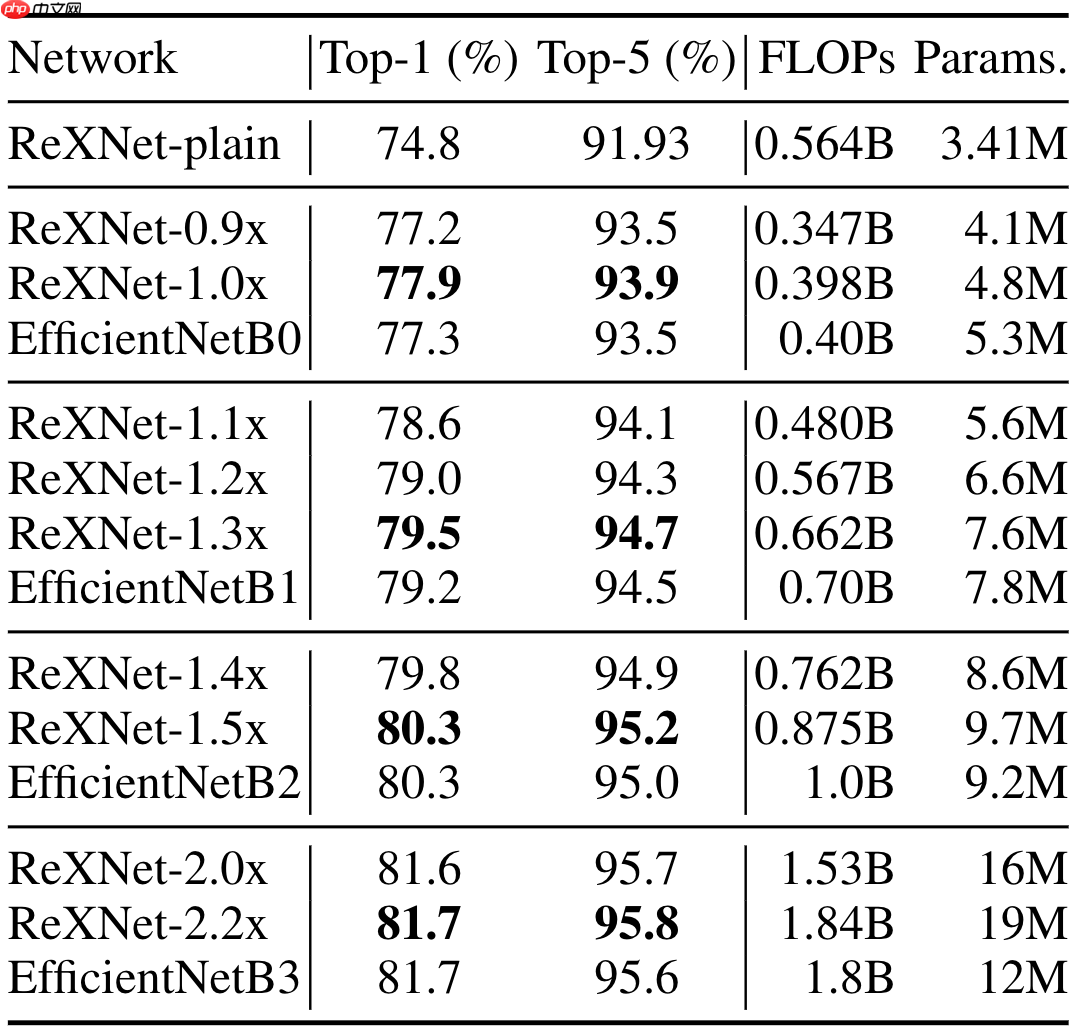本文复现了ReXNet模型,这是一款参数量小、精度高的新BackBone。介绍了其针对深度网络表达瓶颈问题提出的设计准则,还展示了模型搭建的基础模块(如ConvBN、Swish等)、主体结构及预设模型,并进行了模型验证,在ImageNet验证集上取得相应精度。
☞☞☞AI 智能聊天, 问答助手, AI 智能搜索, 免费无限量使用 DeepSeek R1 模型☜☜☜

import paddleimport paddle.nn as nnfrom math import ceil
def ConvBN(out, in_channels, channels, kernel=1, stride=1, pad=0, num_group=1, act=None):
out.append(nn.Conv2D(in_channels, channels, kernel,
stride, pad, groups=num_group, bias_attr=False))
out.append(nn.BatchNorm2D(channels)) if act == 'swish':
out.append(Swish()) elif act == 'relu':
out.append(nn.ReLU()) elif act == 'relu6':
out.append(nn.ReLU6())class Swish(nn.Layer):
def __init__(self):
super(Swish, self).__init__() def forward(self, x):
return x * nn.functional.sigmoid(x)class SE(nn.Layer):
def __init__(self, in_channels, channels, se_ratio=12):
super(SE, self).__init__()
self.avg_pool = nn.AdaptiveAvgPool2D(1)
self.fc = nn.Sequential(
nn.Conv2D(in_channels, channels // se_ratio,
kernel_size=1, padding=0),
nn.BatchNorm2D(channels // se_ratio),
nn.ReLU(),
nn.Conv2D(channels // se_ratio, channels,
kernel_size=1, padding=0),
nn.Sigmoid()
) def forward(self, x):
y = self.avg_pool(x)
y = self.fc(y) return x * yclass LinearBottleneck(nn.Layer):
def __init__(self, in_channels, channels, t, stride, use_se=True, se_ratio=12):
super(LinearBottleneck, self).__init__()
self.use_shortcut = stride == 1 and in_channels <= channels
self.in_channels = in_channels
self.out_channels = channels
out = [] if t != 1:
dw_channels = in_channels * t
ConvBN(out, in_channels=in_channels,
channels=dw_channels, act='swish') else:
dw_channels = in_channels
ConvBN(out, in_channels=dw_channels, channels=dw_channels, kernel=3, stride=stride, pad=1,
num_group=dw_channels) if use_se:
out.append(SE(dw_channels, dw_channels, se_ratio))
out.append(nn.ReLU6())
ConvBN(out, in_channels=dw_channels, channels=channels)
self.out = nn.Sequential(*out) def forward(self, x):
out = self.out(x) if self.use_shortcut:
out[:, 0:self.in_channels] += x return outclass ReXNetV1(nn.Layer):
def __init__(self, input_ch=16, final_ch=180, width_mult=1.0, depth_mult=1.0,
class_dim=1000, use_se=True, se_ratio=12, dropout_ratio=0.2):
super(ReXNetV1, self).__init__()
layers = [1, 2, 2, 3, 3, 5]
strides = [1, 2, 2, 2, 1, 2]
use_ses = [False, False, True, True, True, True]
layers = [ceil(element * depth_mult) for element in layers]
strides = sum([[element] + [1] * (layers[idx] - 1) for idx, element in enumerate(strides)], []) if use_se:
use_ses = sum([[element] * layers[idx] for idx, element in enumerate(use_ses)], []) else:
use_ses = [False] * sum(layers[:])
ts = [1] * layers[0] + [6] * sum(layers[1:])
self.depth = sum(layers[:]) * 3
stem_channel = 32 / width_mult if width_mult < 1.0 else 32
inplanes = input_ch / width_mult if width_mult < 1.0 else input_ch
features = []
in_channels_group = []
channels_group = [] # The following channel configuration is a simple instance to make each layer become an expand layer.
for i in range(self.depth // 3): if i == 0:
in_channels_group.append(int(round(stem_channel * width_mult)))
channels_group.append(int(round(inplanes * width_mult))) else:
in_channels_group.append(int(round(inplanes * width_mult)))
inplanes += final_ch / (self.depth // 3 * 1.0)
channels_group.append(int(round(inplanes * width_mult)))
ConvBN(features, 3, int(round(stem_channel * width_mult)),
kernel=3, stride=2, pad=1, act='swish') for block_idx, (in_c, c, t, s, se) in enumerate(zip(in_channels_group, channels_group, ts, strides, use_ses)):
features.append(LinearBottleneck(in_channels=in_c,
channels=c,
t=t,
stride=s,
use_se=se, se_ratio=se_ratio))
pen_channels = int(1280 * width_mult)
ConvBN(features, c, pen_channels, act='swish')
features.append(nn.AdaptiveAvgPool2D(1))
self.features = nn.Sequential(*features)
self.output = nn.Sequential(
nn.Dropout(dropout_ratio),
nn.Conv2D(pen_channels, class_dim, 1)) def forward(self, x):
x = self.features(x)
x = self.output(x).squeeze() return xdef rexnet_100(pretrained=False, **kwargs):
model = ReXNetV1(width_mult=1.0, **kwargs) return modeldef rexnet_130(pretrained=False, **kwargs):
model = ReXNetV1(width_mult=1.3, **kwargs) return modeldef rexnet_150(pretrained=False, **kwargs):
model = ReXNetV1(width_mult=1.5, **kwargs) return modeldef rexnet_200(pretrained=False, **kwargs):
model = ReXNetV1(width_mult=2.0, **kwargs) return modeldef rexnet_300(pretrained=False, **kwargs):
model = ReXNetV1(width_mult=3.0, **kwargs) return model!mkdir ~/data/ILSVRC2012 !tar -xf ~/data/data68594/ILSVRC2012_img_val.tar -C ~/data/ILSVRC2012
import osimport paddleimport numpy as npfrom PIL import Imageclass ILSVRC2012(paddle.io.Dataset):
def __init__(self, root, label_list, transform):
self.transform = transform
self.root = root
self.label_list = label_list
self.load_datas() def load_datas(self):
self.imgs = []
self.labels = [] with open(self.label_list, 'r') as f: for line in f:
img, label = line[:-1].split(' ')
self.imgs.append(os.path.join(self.root, img))
self.labels.append(int(label)) def __getitem__(self, idx):
label = self.labels[idx]
image = self.imgs[idx]
image = Image.open(image).convert('RGB')
image = self.transform(image) return image.astype('float32'), np.array(label).astype('int64') def __len__(self):
return len(self.imgs)
import paddle.vision.transforms as T
model = rexnet_100()
model.set_dict(paddle.load('data/data75438/rexnetv1_1.0x.pdparams'))
model = paddle.Model(model)
model.prepare(metrics=paddle.metric.Accuracy(topk=(1, 5)))
val_transforms = T.Compose([
T.Resize(256, interpolation='bicubic'),
T.CenterCrop(224),
T.ToTensor(),
T.Normalize(mean=[0.485, 0.456, 0.406], std=[0.229, 0.224, 0.225])
])
val_dataset = ILSVRC2012('data/ILSVRC2012', transform=val_transforms, label_list='data/data68594/val_list.txt')
model.evaluate(val_dataset, batch_size=512)Eval begin... The loss value printed in the log is the current batch, and the metric is the average value of previous step.
/opt/conda/envs/python35-paddle120-env/lib/python3.7/site-packages/paddle/fluid/layers/utils.py:77: DeprecationWarning: Using or importing the ABCs from 'collections' instead of from 'collections.abc' is deprecated, and in 3.8 it will stop working return (isinstance(seq, collections.Sequence) and
step 10/98 - acc_top1: 0.7811 - acc_top5: 0.9396 - 7s/step step 20/98 - acc_top1: 0.7836 - acc_top5: 0.9396 - 7s/step step 30/98 - acc_top1: 0.7813 - acc_top5: 0.9392 - 7s/step step 40/98 - acc_top1: 0.7793 - acc_top5: 0.9383 - 7s/step step 50/98 - acc_top1: 0.7792 - acc_top5: 0.9389 - 7s/step step 60/98 - acc_top1: 0.7797 - acc_top5: 0.9386 - 7s/step step 70/98 - acc_top1: 0.7785 - acc_top5: 0.9386 - 7s/step step 80/98 - acc_top1: 0.7789 - acc_top5: 0.9385 - 7s/step step 90/98 - acc_top1: 0.7786 - acc_top5: 0.9385 - 7s/step step 98/98 - acc_top1: 0.7786 - acc_top5: 0.9387 - 6s/step Eval samples: 50000
{'acc_top1': 0.77862, 'acc_top5': 0.93868}以上就是模型复现:ReXNet的详细内容,更多请关注php中文网其它相关文章!

每个人都需要一台速度更快、更稳定的 PC。随着时间的推移,垃圾文件、旧注册表数据和不必要的后台进程会占用资源并降低性能。幸运的是,许多工具可以让 Windows 保持平稳运行。

Copyright 2014-2025 https://www.php.cn/ All Rights Reserved | php.cn | 湘ICP备2023035733号